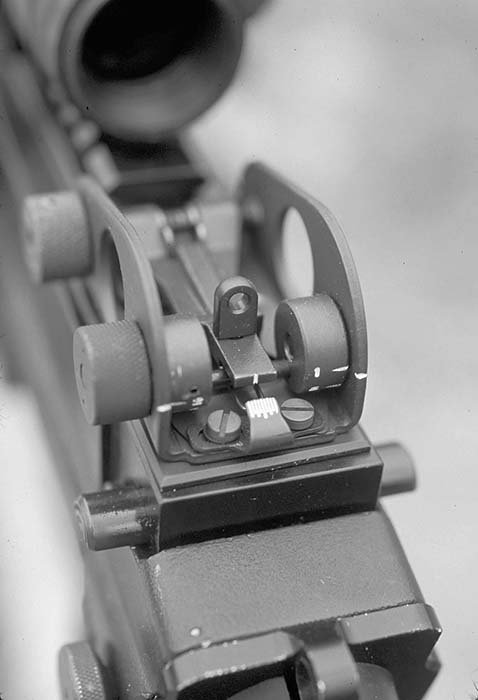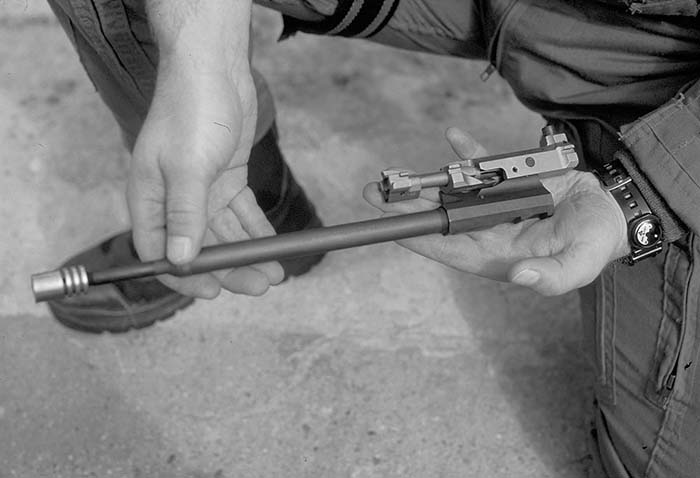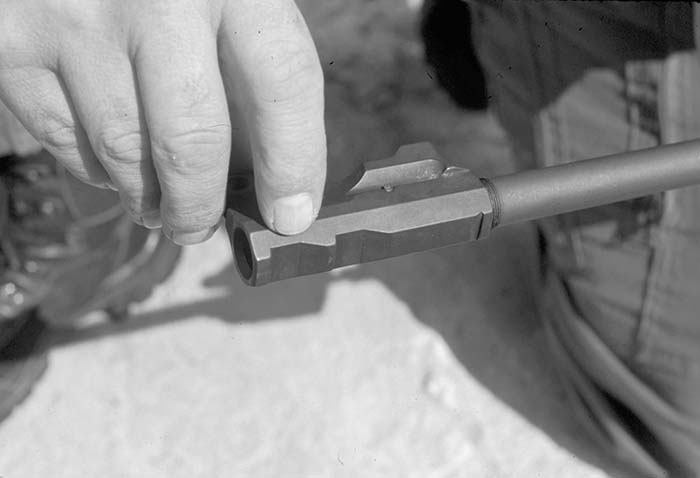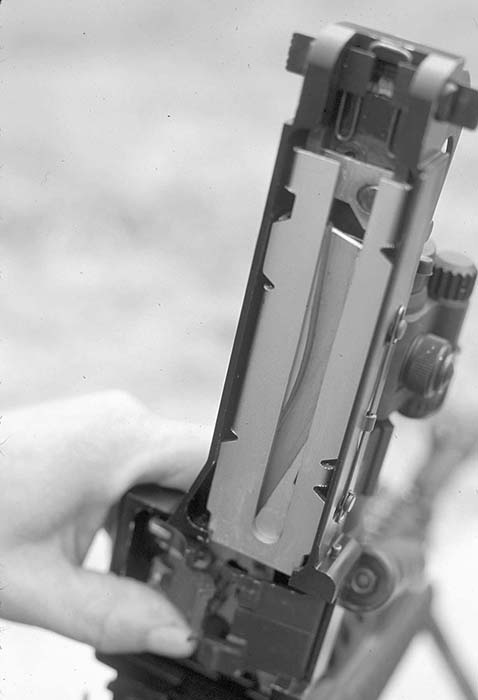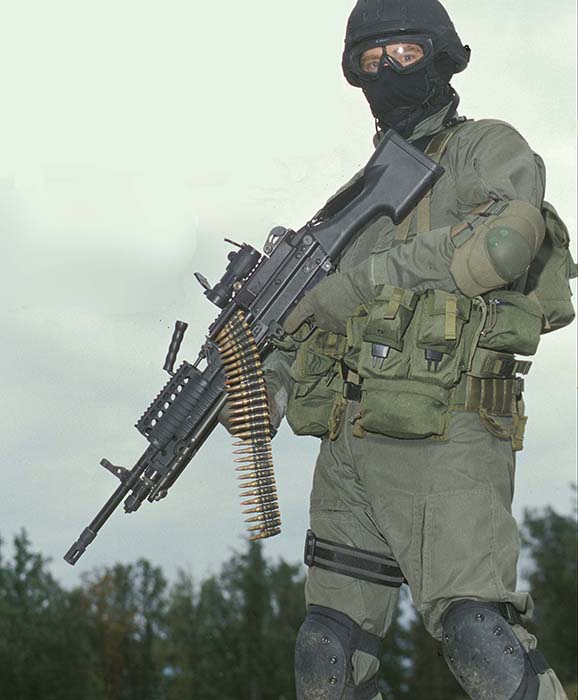SMALL ARMS REVIEW was at the head of the line to field test one of the first production models of the new MK48 7.62mm Light Machine Guns that are now being issued to Navy SEAL teams. This light and compact new slug hose gives hard hitting power to elite units of Special Operations Command in the ongoing War on Terror.
by Robert Bruce
EDITOR’S NOTE: Readers of SMALL ARMS REVIEW got a sneak preview of a prototype version of this exciting weapon in the July ’03 issue. Robert Bruce has been closely following its development and was given the privilege of being first in line to examine and photograph the brand new production version. SAR is proud to present his exclusive report and live fire photos. USSOCOM was given the opportunity to review this feature and their official comments are provided at the end. Dan Shea
As negative statements go in the scrubbed and sanitized world of government briefings, that one is about as strong as they get. Scrape the light coating of sugar off the words and get the underlying message – the chopped and specially configured M60E3s long used by Navy SEALs are worn out, washed up and ripe for replacement.
But those who have watched the glacial pace of Uncle Sam’s weapons procurement bureaucracy know that finding and fielding an effective replacement for the MK43 piglet “within the system” would have to be a long and frustrating process. Meanwhile, SEAL teams and other special warriors on the front lines of the War on Terror would have to make do with alternate slug hoses of smaller caliber or considerable weight.
It is apparent that neither option was acceptable to the operators and to the dedicated men and women working to support them from behind the scenes at US Special Operations Command. An innovative fast track program was formally launched early in 2001.
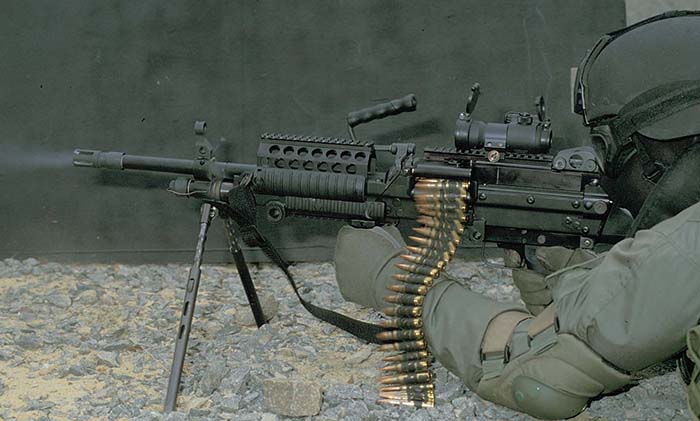
All the World’s Weapons
Not to say that some other available hardware “in the system” wasn’t serviceable and effective. SEALs are said to be pretty happy with their 5.56x45mm belt-fed MK46 Mod 0, a modified version of FN’s superlative M249 SAW (Squad Automatic Weapon). The 7.62x51mm M240 – another FN design known to be astonishingly reliable under the worst conditions – rides shotgun on most SEAL support vehicles, air and watercraft.
But neither weapon is optimal for some critical SEAL requirements. 5.56x45mm doesn’t have the range and penetration often needed, and all M240 variants are as heavy as anvils no matter how short the barrel and buttstock.
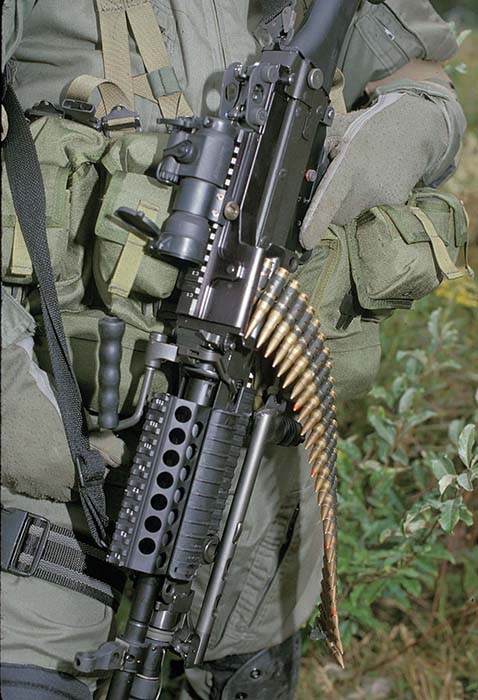
Luckily, SEALs have the advantage of a highly motivated support structure that works hard to stay ahead of the technology curve by constantly updating a working inventory of free world and threat weaponry.
EDITOR’S NOTE: SAR’s readers joined Robert Bruce “Behind the Wire” at NSWC Crane for a look at some of these in the December 2002 issue.
Operators can visit NSWC Crane and other locations to conduct hands-on assessments of any number of small, medium and large caliber machine guns such as the Singapore ULTIMAX, German HK21 and all the old and new Soviet-style and Chinese weaponry.
Also, they regularly compare hardware with their counterparts in allied SPECOPS units. Just about anything in production worldwide is of interest and under scrutiny.
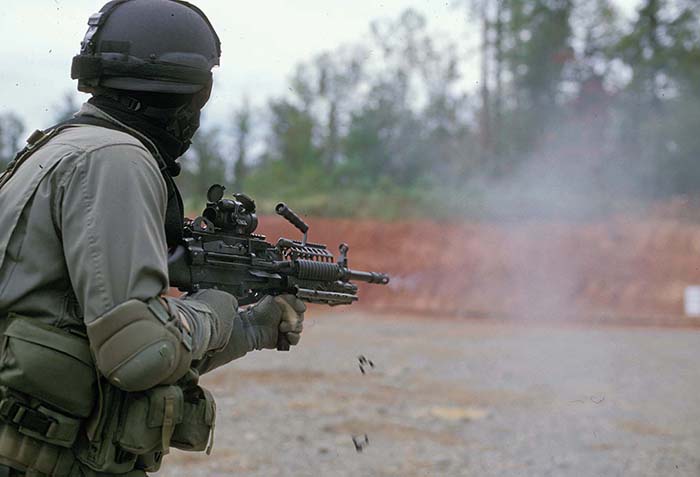
To make sure all the bases were covered a formal RFI (Request For Information) or “market survey” was posted by NSWC on 8 January 2001. This document sought information from all manufacturers with existing 7.62x51mm Light Machine Guns who believed their weapons might meet SOCOM’s severe performance objectives. However, there was only a three-week response window and the next big step would be to deliver sample guns for testing.
FN’s proposal included the very important point that FNMI, the Belgian conglomerate’s American operation, would actually be making the guns. This South Carolina based facility has earned an excellent reputation in making both the M240 and M249 series of weapons and was instrumental in “SEALizing” the SAW into the MK46.
It was also known that the FN MINIMI, the original Belgian version that became the US M249, started life in 7.62x51mm. Since a lot of engineering had been done and a pair of fully operational prototypes existed, most of the hard part was past. While not exactly NDI (Non-Developmental Item) or COTS (Commercial Off-The-Shelf) by strictest definition, this was close enough so FN passed the first hurdle.
EDITOR’S NOTE: SAR readers can find complete details on the original MINIMI in Peter Kokalis’ authoritative report in the July 2003 issue.
When the gun smoke cleared after testing sample guns the operators and technical staff found all candidates wanting except FN’s pumped-up SAW — the M249/MK46 in 7.62x51mm. Why? For a long list of reasons including exceptional reliability, mechanical commonality, handling characteristics requiring little or no transition from one weapon to the other, and confidence in FN’s team to do the job right.
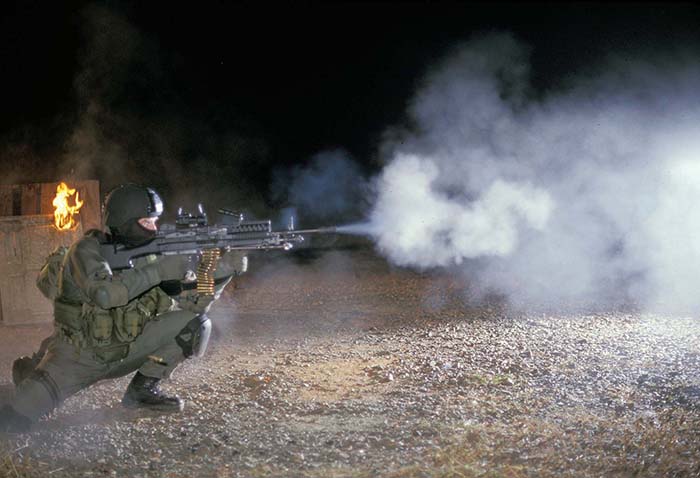
Shooting Through the Red Tape
“FN Manufacturing, Inc., Columbia. SC, is being awarded a …firm-fixed-price, indefinite-delivery and indefinite-quantity contract for 2,500 7.62mm lightweight machine guns (LWMG) and auxiliary support equipment (barrels, tool and gauge kits, collapsible stocks and blank firing barrels)… to be completed by March 2007.” Department of Defense Contract Announcement, 13 March 2002
Somehow managing to keep the small arms procurement establishment at arms length, USSOCOM stayed in control. Their “Roadmap for Success” should be mandatory for any Dilbert cartoon characters in government who insist on putting process ahead of results:
Streamlined Acquisition – cut out redundant and unnecessary layers of bureaucracy, do your homework, write realistic but stringent specifications, build in flexibility.
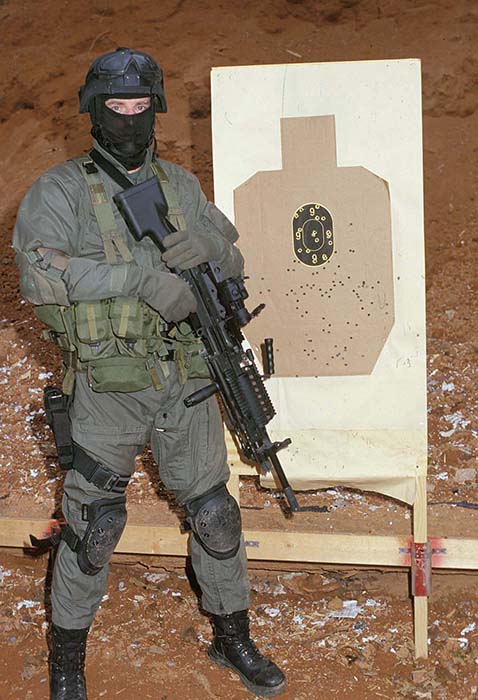
Up-front Operator/Developer/Industry Involvement – make sure all parties are talking and responding with their best ideas right from the start.
“Fly Before You Buy” Test Strategy — have a rigorous program of formal and operational testing that reveals problems for quick-fix while the program continues moving forward.
Weapon/Vendor Performance — reward success and penalize failure. A proven team like that of FN Herstal and its American subsidiary FN Manufacturing will get the job done. The MK48 is said to have met or exceeded all performance objectives.
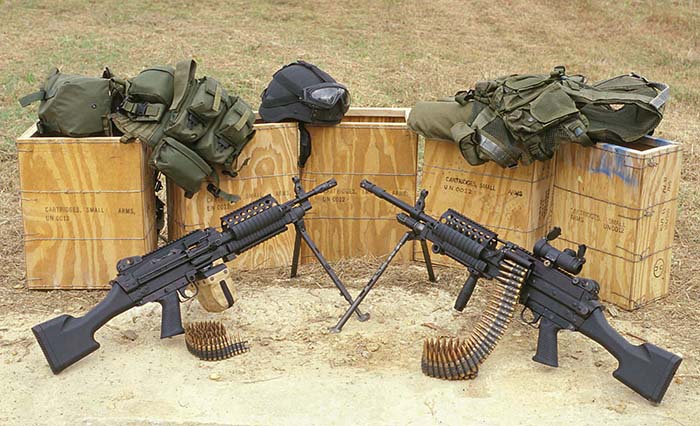
A USSOCOM Success Story
The Program Manager for Special Operations Forces is justifiably proud of the government/industry teamwork that has resulted in the Mark 48 Mod 0. This 7.62x51mm belt-fed Light Machine Gun has been thoroughly tested, debugged, repeatedly made “new and improved,’ put into series production, and no doubt already been in the thick of things for quite awhile over in Central Command’s area of operations.
We are told that the initial production run of some 500 guns is “moving smoothly” at FNMI in Columbia, SC and the way is clear for the certainty of adding considerably to this number as Rangers and other SOCOM entities get a chance to test drive the weapons.
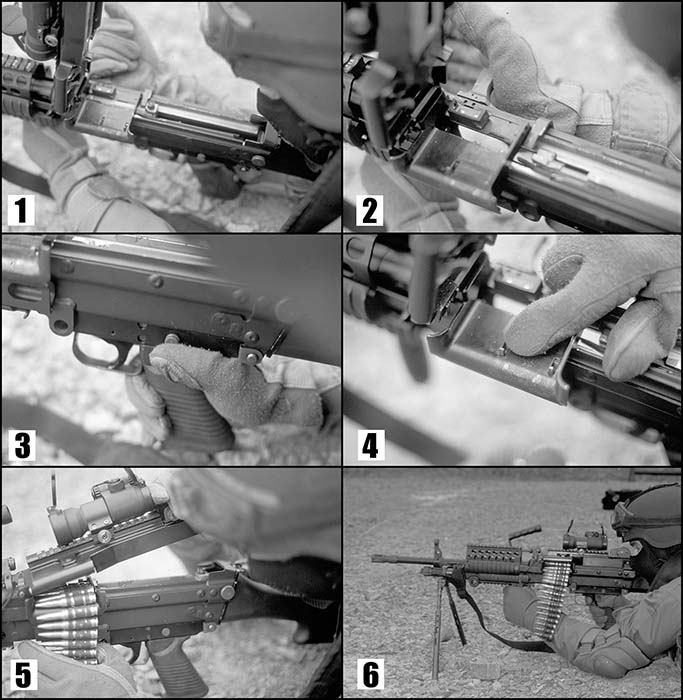
MINIMI to MAXIMI
The MK46 and the new MK48 guns are quite similar externally in having matte black Teflon coated stamped steel receivers adorned with MIL-STD-1913 rails, folding bipods, quick-change barrels with chromed bores, and distinctively configured synthetic stocks. Aside from the obvious re-chambering from 5.56x45mm to the bigger and far more energetic 7.62x51mm NATO cartridge family, the MK48 has several key areas of redesign to set it apart from its “Little Brother,” the MK46.
External recognition features on “Big Brother” include a barrel that’s longer by nearly 4 inches for efficient powder burning and bullet pushing. Its improved bipod has been repositioned a couple of inches forward so as not to interfere with items clamped on the four MIL-STD-1913 rails on the handguard perimeter. The MK48 also has a swiveling carrying handle and a belt-box hanger on the feed tray.
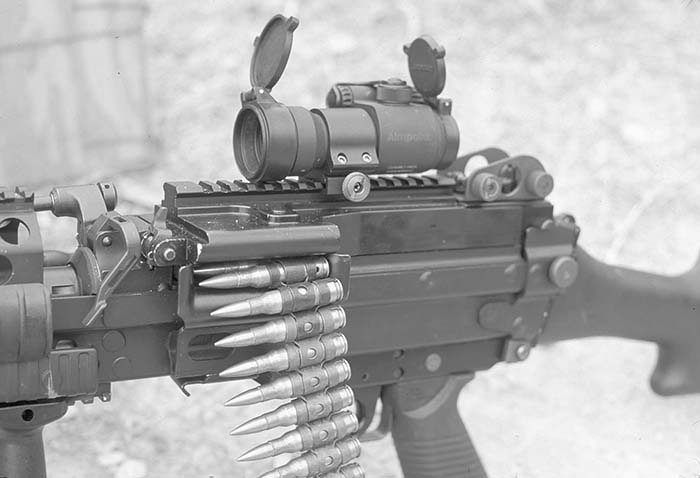
Its pistol grip and trigger housing group have been moved rearward 15mm (about 9/16-inch) to keep the gunner’s fingers safely out of the path of brass casings spinning out from the necessarily-enlarged ejection port. This position also allows the sear to grab the newly added “anti-runaway” notch on the operating rod.
There is little change internally as the MK48 is essentially a beefed-up MINIMI using the same type gas system and configuration of the assembly formed by the piston, bolt and its carrier. The piston now has two sear notches on the bottom surface with the extra one at the rear. This is the anti-runaway feature, allowing the sear to catch the rear notch in extreme situations where the bolt is not blown back far enough. No provision is made for adjustment of the gas piston as this was apparently found in testing to be unnecessary.
The bolt has heftier locking lugs to handle the higher chamber pressure and its extractor is noticeably bigger to resist breakage and rim ripping of cartridges being pulled from a gritty or fouled chamber.
The feed cover assembly is reinforced with guide plates astride the feed lever (often called the roller guide track) that resist deforming torque from the more-powerful 7.62x51mm ammo. As with the Mk46, it’s topped with a respectable length of MIL-STD-1913 rail for sight clamping.
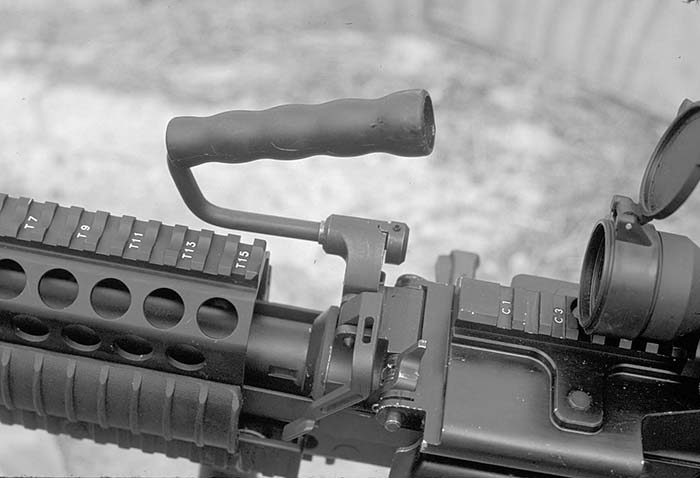
SEAL Slug Slinger
The resulting weapon is a case study in compact efficiency for combat in all environments. Since SOCOM has released no details of the test regimen and only a few of the test results let’s go through the back door and look at some key requirements listed in a string of official procurement documents beginning in January 2001:The weapon system shall be corrosion resistant … capable of being submerged in salt and fresh water to a depth of 66 feet for a minimum of 8 hours, surfaced, drained without disassembly, and reliably function in 1 minute or less.The LWMG receiver shall have a minimum service life of 50,000 rounds with the objective of 100,000 rounds.The LMG barrel life requirement is 10,000 rounds before major accuracy degradation. The objective is 25,000 rounds.The LMG reliability requirement is for a mean rounds between stoppages (MRBS) of 4,000 rounds. The objective is a MRBS of 8,000 rounds.
It would seem that these and many more types of extreme environment tests were met and overcome and that all objectives have been realized in the final production version.
With the big problems licked SOCOM has launched a search for some other niceties for the MK46 and MK48 brotherhood. A formal RFI (request for information) was posted on 28 Feb 03 for “Lightweight Machine Gun Muzzle Brake and Suppressors for small arms in 5.56mm and 7.62mm….” Details are available to all including Syrians, Iranians, North Koreans, and CNN at www1.eps.gov/spg/DON/NAVSEA/N00164/N0016403R0035/SynopsisR.html
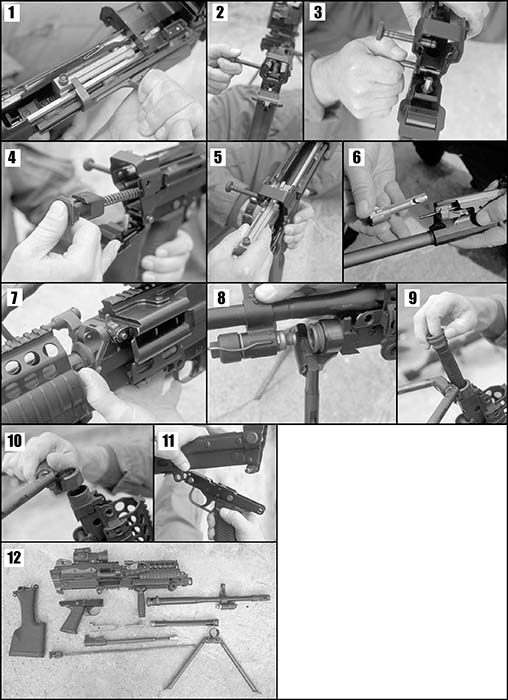
Live Fire Photo Session
Profuse thanks to the folks at FN Manufacturing for making one of the first production run guns available and to those at FNH USA who arranged and facilitated a live fire session. Although not nearly a formal test, the several hours we spent on the range in rural Stafford County, Virginia at Crucible Training Center served quite well to get a good feel for the weapon’s characteristics, capabilities and handling.
Our gunner’s Nomex hood and flight coveralls are no mere affectation and all of his other gear is real stuff for the real world. He is an independent contractor to FN who asked to remain anonymous for a host of reasons including recent service in Naval Special Warfare and continuing work in interesting places around the globe. Closely involved with some of the laborious and demanding process of perfecting the MK48 at flank speed, he provided us with invaluable insight to its evolution as guided by SEAL operators and translated into metal by the multi-faceted FN team.
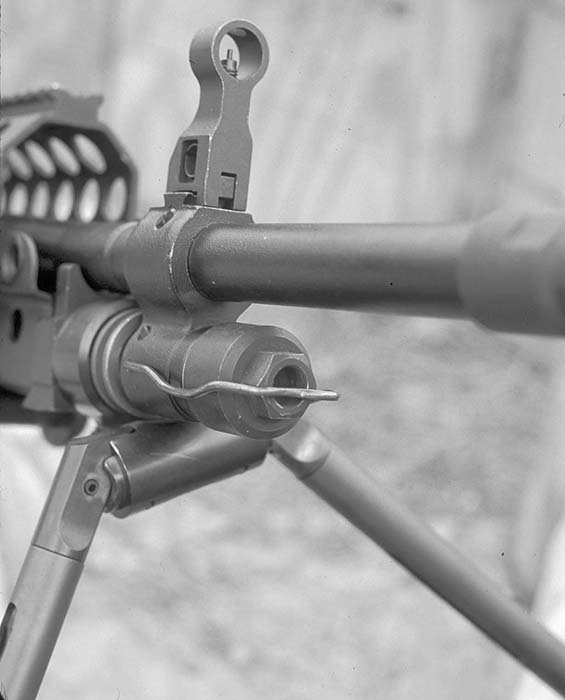
However, his comments were necessarily off the record and, as SAR has not been given permission to repeat them, we will respect this confidence. That said, any RKI (reasonably knowledgeable individual) should be able to easily read between the lines of this feature and captions for its accompanying photos.
More than 500 rounds of standard M80 ball and a bit of M62 tracer were fired with no stoppages from all the standard shooting positions in our photo/test session. Our own turn at the trigger for some short and long bursts revealed a weapon that is nicely balanced between modest weight and recoil absorbing mass. Controllability depends on this, aided by attention to ergonomics and the deceptively simple but remarkably effective addition of a foregrip under the barrel shroud. Of course they got it right.
Elementary Internet Espionage
FN Manufacturing, Inc.
www.fnmfg.com
click “Products”
MK46/MK48 Briefing
www.dtic.mil/ndia/2003smallarms/
click “Family of SOF Machine Guns”
A Russian Perspective
http://world.guns.ru/machine/mg38-e.htm
A Close Look at the MK48 MOD 0
Readers of SMALL ARMS REVIEW got a close up view of an early prototype of this remarkable weapon in Editor Dan Shea’s piece in the July 2003 issue. And, by the way, this got SAR into a bit of hot water with some of the players for “jumping the gun” by prematurely revealing its details. Although probably unrelated to this, USSOCOM has clamped a tight lid on information regarding the weapon’s development, production and employment to the interesting extent of even refusing to release the text from cleared briefings previously given at such open forums as NDIA Small Arms.
SAR has no intention of revealing any information that will be of value to Freedom’s many foes nor will in any way put American and Allied forces in danger. However, we can use the Internet and other sources of official government “public domain” information nearly as well as enemies like al-Qaida and other hostile intelligence services.
We can also look at the detailed photos that accompany this feature and any of hundreds of thousands of FN MINIMI/US M249 SAWs to readily discern how the damn thing works regardless of caliber….
So, what follows is mostly what anybody can find out with a little research.
SOCOM Speaks Up
In the interest of fairness and accuracy, SAR gave MK48 Program personnel the opportunity to review and comment on Robert Bruce’s report. Significantly, no factual errors were found but some fine-tuning was requested. Relevant responses are provided here.
“The bottom line is that the M60/Mk43/M60E3 was at the end of its life cycle, plus USSOCOM had a requirement for a lighter, more versatile weapon.”
“SOCOM is satisfied with the performance of their Family of Lightweight Machine Guns.”
“SOCOM fielded the MK48 almost a year ahead of schedule and on cost.”
“The MK46 was a finalist for the David Packard Award for Acquisition Excellence in 2002 and the MK48 followed the same path.”
This article first appeared in Small Arms Review V7N10 (July 2004)
